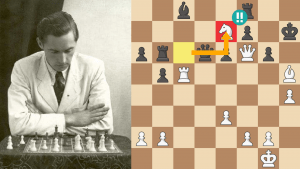
Mastering Squares, Part 3
I noticed that some readers had trouble understanding what a weak square is. I don’t like leaving people behind, so I am going to devote 75.23 percent of this week’s “Mastering Squares” article to square basics.
Of course, I won’t forget the stronger players! The final example should prove instructive for those at class C right up to master.
A square becomes weak (or at the very least potentially weak) if one of its pawns can’t protect it, while in most cases an enemy pawn is claiming it (though it’s not obligatory).
Take a look at the d4 and d5 squares. White doesn’t have a pawn that can protect d4, but Black’s pawn on e5 is claiming it. The d5-square isn’t a hole since Black’s c6-pawn is defending it (simply put, White would not want to put a knight on d5 since it would be eaten by the c6-pawn).

Here’s a slightly more complex example.
There are three weak squares: d6 (It’s impossible for a Black pawn to protect it, while White’s pawns on c5 and e5 are claiming it), d5 (White’s pawns can’t protect it, but Black’s pawns on c6 and e6 are claiming), and e4 (Black’s f5-pawn is claiming it, while White doesn’t have a pawn that can defend it).
In general, when we talk about weak squares, we’re referring to squares on the 3rd, 4th, 5th, and 6th ranks, and squares with central squares being particularly prized (though there are many exceptions).
All that is well and good, but why are weak squares important? You can’t capture one, so what’s the big deal? The big deal is that a weak square can easily turn into an unassailable home for an enemy piece.
Weak squares are also referred to as holes (an obvious analogy) and support points (secure homes for your pieces). Knights often are the piece you most want to place on a support point since they aren’t long range. Thus the closer they get to the enemy, the better.
It’s VERY important to train yourself to instantly see weak squares. If you don’t notice them, then you won’t use them. Unfortunately for you, your opponent will, and you’ll be left in the dust when you play someone with experience.
See if you can find a way to get both knights to their dream squares – White to the hole on d6, and Black to the hole on d5.
Okay, now it’s time to really increase the complexity:
This is just a barebones position. We’ll fill it with pieces in a moment. In the meantime, point out squares that you think are weak.
The b5 and d5 squares can be used by a White piece, but Black would be able to chase them away with ...c7-c6. Thus, they are not holes. After 1.Kf2 c5, then both b5 and d5 are true holes/weak squares. Thus in most cases Black would avoid ...c7-c5 since it hands over squares to the enemy.
The d4-square is a weak square, though Black might want to try and dominate it without using his c-pawn since we’ve already seen that ...c5 would give up two squares (b5 and d5) while laying claim to just one (b4 isn’t a weak square since White can play a3 and protect it).
The c5-square is quite interesting. This is known as an artificial support point since Black’s a5-pawn is preventing White’s b3-pawn from moving forward and protecting c5. A Black knight or bishop would be very happy there!
Did you notice c6? That’s a hole, though at the moment a White pawn can’t claim it. However, in many positions White’s pieces would be able to make use of c6.

The e5-square is yet another artificial support point since Black can’t protect it with ...f6 due to the g5-pawn. Another hole is g4, which could be used by a Black queen or bishop. In fact, since White’s kingside pawns have advanced so far, most of the squares on the 3rd rank (d3, e3, f3, g3, and h3) are vulnerable.
Finally, a trained eye would drool at the sight of the f6 and f5 squares. Black would sell his firstborn son to get a knight on f5, since a pawn couldn’t chase it away and it would also hit White’s h4-pawn. And f6... ahhhh... It’s like an open door (or open invitation!) to Black’s kingside. A knight would be a happy camper if it could reach that square. Also note that the whole a1-h8 diagonal (every single square on that diagonal!) is so vulnerable it’s literally the stuff of dreams.
Having said that, the squares along the h1-a8 diagonal are also aiming at White’s king!
All in all, position five is rife with vulnerable squares and holes. I recommend that you take a moment and absorb the square-Armageddon that’s in front of you. Imagine the board is full of pieces, and then imagine how lovely they would be on some of those squares!
Now let’s drop some pieces into the previous diagram.
Black dreams of ...Nf5 hitting White’s queen, and ...Nc5, heading for d3. The vulnerable squares on the h1-a8 diagonal have been nullified by White’s g2-bishop, but the a1-h8 diagonal is screaming for Bb2 with, somehow or other, Qc3 to follow when Qg7 or Qh8 mates are in the air.
By making a compartment in your brain that mulls over weak squares whenever your eyes happen upon a chessboard, you’ll automatically think of these things. In turn, this thinking process will allow you to get the maximum for either side when you are facing positions like this.
Instead of looking at the board and seeing nothing but white noise, you will immediately know what needs to be done. The only real work at that point is figuring out how to do it!
Here’s a possible continuation. Players of all levels should pay close attention to the vast importance of the f6-square and the a1-h8 diagonal. The fate of both players is riding on those two things!
Of course, lower-rated players won’t fully understand all the particulars, but just looking at those points I just mentioned will help you realize how critical it is to train your brain in the ways of weak squares!
For those wondering why 8...Nc5 wasn’t better than 8...Nb8, check out the following puzzle. Be warned, it’s extremely complicated.
Puzzle:
LESSONS FROM THIS ARTICLE:
-
Like a dog that’s been trained to sniff out drugs, every chess player needs to be trained to sniff out weak squares.
-
Though there are many levels of weak squares, the most basic is an advanced central square that can’t be protected by the enemy pawn, while your pawn(s) have grabbed it by the neck and won’t let go.
-
In a nutshell, a weak square (in the heart of the opponent’s position) should be viewed as a potential home for your pieces. In a way, a knight that's sitting deep in the enemy camp is like a parasite, sucking the life-blood from his position.
-
Okay, I could come up with one grizzly metaphor after another, but like the old Scared Straight TV series that terrified young would-be criminals, not understanding weak squares is like… oh god, I’m doing it again!
RELATED STUDY MATERIAL
-
Read IM Silman's previous article: Mastering Squares, Part 2.
-
Watch IM Rusa Goletiani's video: Stop Your Opponent's Best Moves!
-
Take a lesson on endgame mistakes in the Chess Mentor.
-
Solve some puzzles in the Tactics Trainer.
-
Looking for articles with deeper analysis? Try our magazine: The Master's Bulletin.






